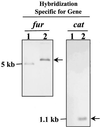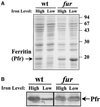Regulation of ferritin-mediated cytoplasmic iron storage by the ferric uptake regulator homolog (Fur) of Helicobacter pylori
- PMID: 11029412
- PMCID: PMC94726
- DOI: 10.1128/JB.182.21.5948-5953.2000
Regulation of ferritin-mediated cytoplasmic iron storage by the ferric uptake regulator homolog (Fur) of Helicobacter pylori
Abstract
Homologs of the ferric uptake regulator Fur and the iron storage protein ferritin play a central role in maintaining iron homeostasis in bacteria. The gastric pathogen Helicobacter pylori contains an iron-induced prokaryotic ferritin (Pfr) which has been shown to be involved in protection against metal toxicity and a Fur homolog which has not been functionally characterized in H. pylori. Analysis of an isogenic fur-negative mutant revealed that H. pylori Fur is required for metal-dependent regulation of ferritin. Iron starvation, as well as medium supplementation with nickel, zinc, copper, and manganese at nontoxic concentrations, repressed synthesis of ferritin in the wild-type strain but not in the H. pylori fur mutant. Fur-mediated regulation of ferritin synthesis occurs at the mRNA level. With respect to the regulation of ferritin expression, Fur behaves like a global metal-dependent repressor which is activated under iron-restricted conditions but also responds to different metals. Downregulation of ferritin expression by Fur might secure the availability of free iron in the cytoplasm, especially if iron is scarce or titrated out by other metals.
Figures








Similar articles
-
The role of the Ferric Uptake Regulator (Fur) in regulation of Helicobacter pylori iron uptake.Helicobacter. 2002 Aug;7(4):237-44. doi: 10.1046/j.1523-5378.2002.00088.x. Helicobacter. 2002. PMID: 12165031
-
Proteomic analysis of a ferric uptake regulator mutant of Helicobacter pylori: regulation of Helicobacter pylori gene expression by ferric uptake regulator and iron.Proteomics. 2004 Jul;4(7):2014-27. doi: 10.1002/pmic.200300740. Proteomics. 2004. PMID: 15221763
-
Essential role of ferritin Pfr in Helicobacter pylori iron metabolism and gastric colonization.Infect Immun. 2002 Jul;70(7):3923-9. doi: 10.1128/IAI.70.7.3923-3929.2002. Infect Immun. 2002. PMID: 12065536 Free PMC article.
-
The ferric uptake regulator of Helicobacter pylori: a critical player in the battle for iron and colonization of the stomach.Future Microbiol. 2013 Jun;8(6):725-38. doi: 10.2217/fmb.13.43. Future Microbiol. 2013. PMID: 23701330 Free PMC article. Review.
-
Transcriptional regulation by Ferric Uptake Regulator (Fur) in pathogenic bacteria.Front Cell Infect Microbiol. 2013 Oct 2;3:59. doi: 10.3389/fcimb.2013.00059. eCollection 2013. Front Cell Infect Microbiol. 2013. PMID: 24106689 Free PMC article. Review.
Cited by
-
In vitro analysis of protein-operator interactions of the NikR and fur metal-responsive regulators of coregulated genes in Helicobacter pylori.J Bacteriol. 2005 Nov;187(22):7703-15. doi: 10.1128/JB.187.22.7703-7715.2005. J Bacteriol. 2005. PMID: 16267295 Free PMC article.
-
Identification of Proteins Related to Nickel Homeostasis in Helicobater pylori by Immobilized Metal Affinity Chromatography and Two-Dimensional Gel Electrophoresis.Met Based Drugs. 2008;2008:289490. doi: 10.1155/2008/289490. Met Based Drugs. 2008. PMID: 18288244 Free PMC article.
-
Fur is required for the activation of virulence gene expression through the induction of the sae regulatory system in Staphylococcus aureus.Int J Med Microbiol. 2011 Jan;301(1):44-52. doi: 10.1016/j.ijmm.2010.05.003. Epub 2010 Aug 12. Int J Med Microbiol. 2011. PMID: 20705504 Free PMC article.
-
The Helicobacter pylori CrdRS two-component regulation system (HP1364/HP1365) is required for copper-mediated induction of the copper resistance determinant CrdA.J Bacteriol. 2005 Jul;187(13):4683-8. doi: 10.1128/JB.187.13.4683-4688.2005. J Bacteriol. 2005. PMID: 15968080 Free PMC article.
-
Metalloregulation of Helicobacter pylori physiology and pathogenesis.Front Microbiol. 2015 Sep 2;6:911. doi: 10.3389/fmicb.2015.00911. eCollection 2015. Front Microbiol. 2015. PMID: 26388855 Free PMC article. Review.
References
-
- Alm R A, Ling L S, Moir D T, King B L, Brown E D, Doig P C, Smith D R, Noonan B, Guild B C, deJonge B L, Carmel G, Tummino P J, Caruso A, Uria-Nickelsen M, Mills D M, Ives C, Gibson R, Merberg D, Mills S D, Jiang Q, Taylor D E, Vovis G F, Trust T J. Genomic-sequence comparison of two unrelated isolates of the human gastric pathogen Helicobacter pylori. Nature. 1999;397:176–180. - PubMed
-
- Althaus E W, Outten C E, Olson K E, Cao H, O'Halloran T V. The Ferric Uptake Regulation (Fur) repressor is a zinc metalloprotein. Biochemistry. 1999;38:6559–6569. - PubMed
-
- Andrews S C. Iron storage in bacteria. Adv Microb Physiol. 1998;40:281–351. - PubMed
-
- Ausubel F M, Brent R, Kingston R E, Moore D D, Seidman J G, Smith J A, Struhl K. Short protocols in molecular biology. New York, N.Y: John Wiley & Sons; 1992.
Publication types
MeSH terms
Substances
LinkOut - more resources
Full Text Sources
Other Literature Sources
Molecular Biology Databases

